Business Model Analysis: IBM and the Impact of Big Data on Business
VerifiedAdded on 2020/03/13
|11
|2180
|53
Essay
AI Summary
This essay conducts a comprehensive analysis of IBM's business model, exploring its framework, value chain, and the influence of big data on its operations. The essay begins by defining the concept of a business model and its significance in the contemporary economy, where customer-centric approaches and cost-effective solutions are paramount. It then delves into the E-business archetypes, the business model as an activity system, and the cost-revenue architecture, illustrating how these components contribute to value creation and profit generation. The essay further examines the business model framework, outlining the roles of resources, design principles, and capabilities. Finally, the essay focuses on IBM as a case study, highlighting how the company's value chain service optimizes profit by emphasizing core competencies, improving customer satisfaction, and adapting to the challenges and opportunities presented by the rise of big data. The conclusion emphasizes the importance of well-designed business and value chain models for organizational success and customer satisfaction.

Running head: BUSINESS MODEL
Business Model
Name of the Student
Name of the University
Author note
Business Model
Name of the Student
Name of the University
Author note
Paraphrase This Document
Need a fresh take? Get an instant paraphrase of this document with our AI Paraphraser
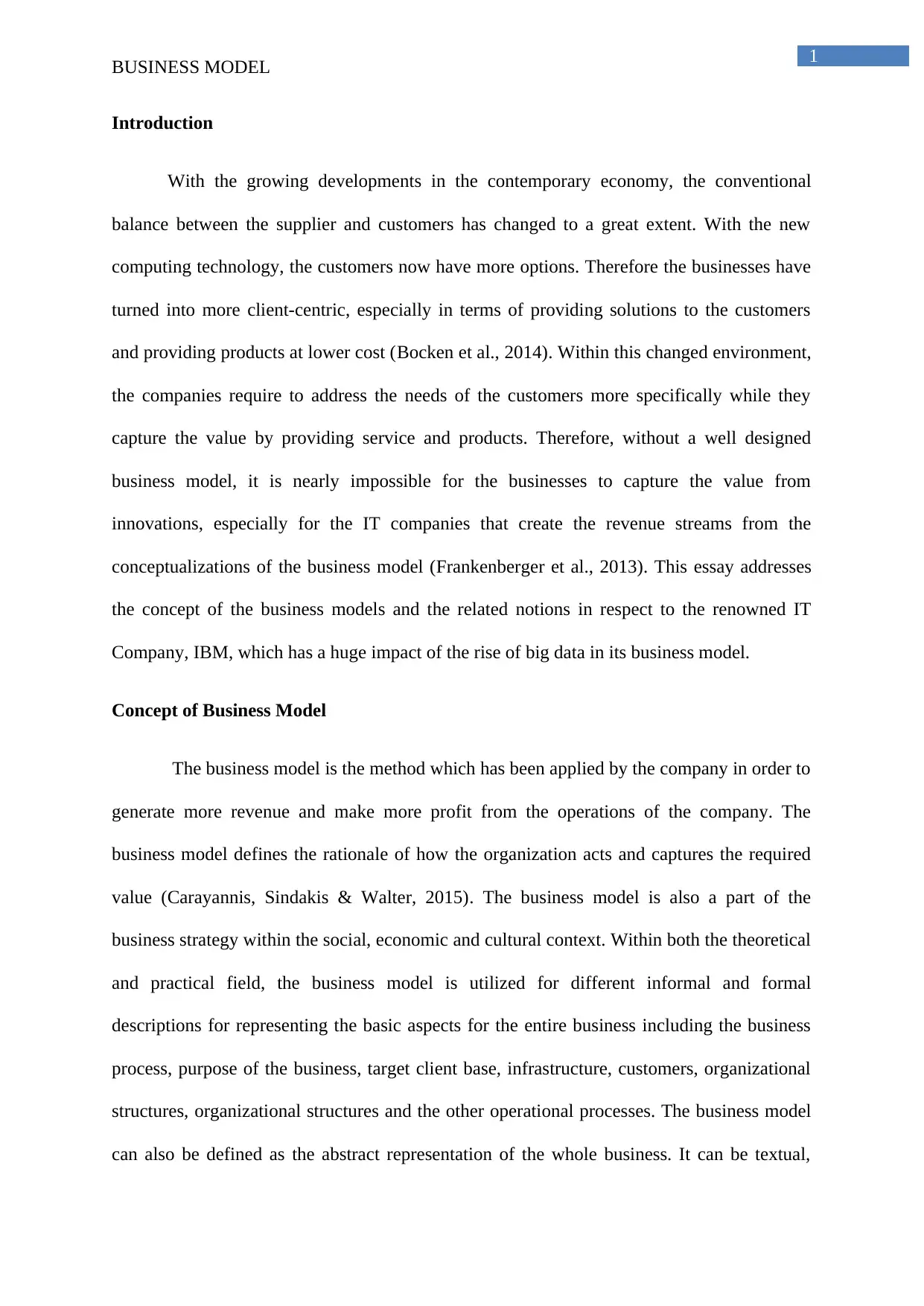
1
BUSINESS MODEL
Introduction
With the growing developments in the contemporary economy, the conventional
balance between the supplier and customers has changed to a great extent. With the new
computing technology, the customers now have more options. Therefore the businesses have
turned into more client-centric, especially in terms of providing solutions to the customers
and providing products at lower cost (Bocken et al., 2014). Within this changed environment,
the companies require to address the needs of the customers more specifically while they
capture the value by providing service and products. Therefore, without a well designed
business model, it is nearly impossible for the businesses to capture the value from
innovations, especially for the IT companies that create the revenue streams from the
conceptualizations of the business model (Frankenberger et al., 2013). This essay addresses
the concept of the business models and the related notions in respect to the renowned IT
Company, IBM, which has a huge impact of the rise of big data in its business model.
Concept of Business Model
The business model is the method which has been applied by the company in order to
generate more revenue and make more profit from the operations of the company. The
business model defines the rationale of how the organization acts and captures the required
value (Carayannis, Sindakis & Walter, 2015). The business model is also a part of the
business strategy within the social, economic and cultural context. Within both the theoretical
and practical field, the business model is utilized for different informal and formal
descriptions for representing the basic aspects for the entire business including the business
process, purpose of the business, target client base, infrastructure, customers, organizational
structures, organizational structures and the other operational processes. The business model
can also be defined as the abstract representation of the whole business. It can be textual,
BUSINESS MODEL
Introduction
With the growing developments in the contemporary economy, the conventional
balance between the supplier and customers has changed to a great extent. With the new
computing technology, the customers now have more options. Therefore the businesses have
turned into more client-centric, especially in terms of providing solutions to the customers
and providing products at lower cost (Bocken et al., 2014). Within this changed environment,
the companies require to address the needs of the customers more specifically while they
capture the value by providing service and products. Therefore, without a well designed
business model, it is nearly impossible for the businesses to capture the value from
innovations, especially for the IT companies that create the revenue streams from the
conceptualizations of the business model (Frankenberger et al., 2013). This essay addresses
the concept of the business models and the related notions in respect to the renowned IT
Company, IBM, which has a huge impact of the rise of big data in its business model.
Concept of Business Model
The business model is the method which has been applied by the company in order to
generate more revenue and make more profit from the operations of the company. The
business model defines the rationale of how the organization acts and captures the required
value (Carayannis, Sindakis & Walter, 2015). The business model is also a part of the
business strategy within the social, economic and cultural context. Within both the theoretical
and practical field, the business model is utilized for different informal and formal
descriptions for representing the basic aspects for the entire business including the business
process, purpose of the business, target client base, infrastructure, customers, organizational
structures, organizational structures and the other operational processes. The business model
can also be defined as the abstract representation of the whole business. It can be textual,
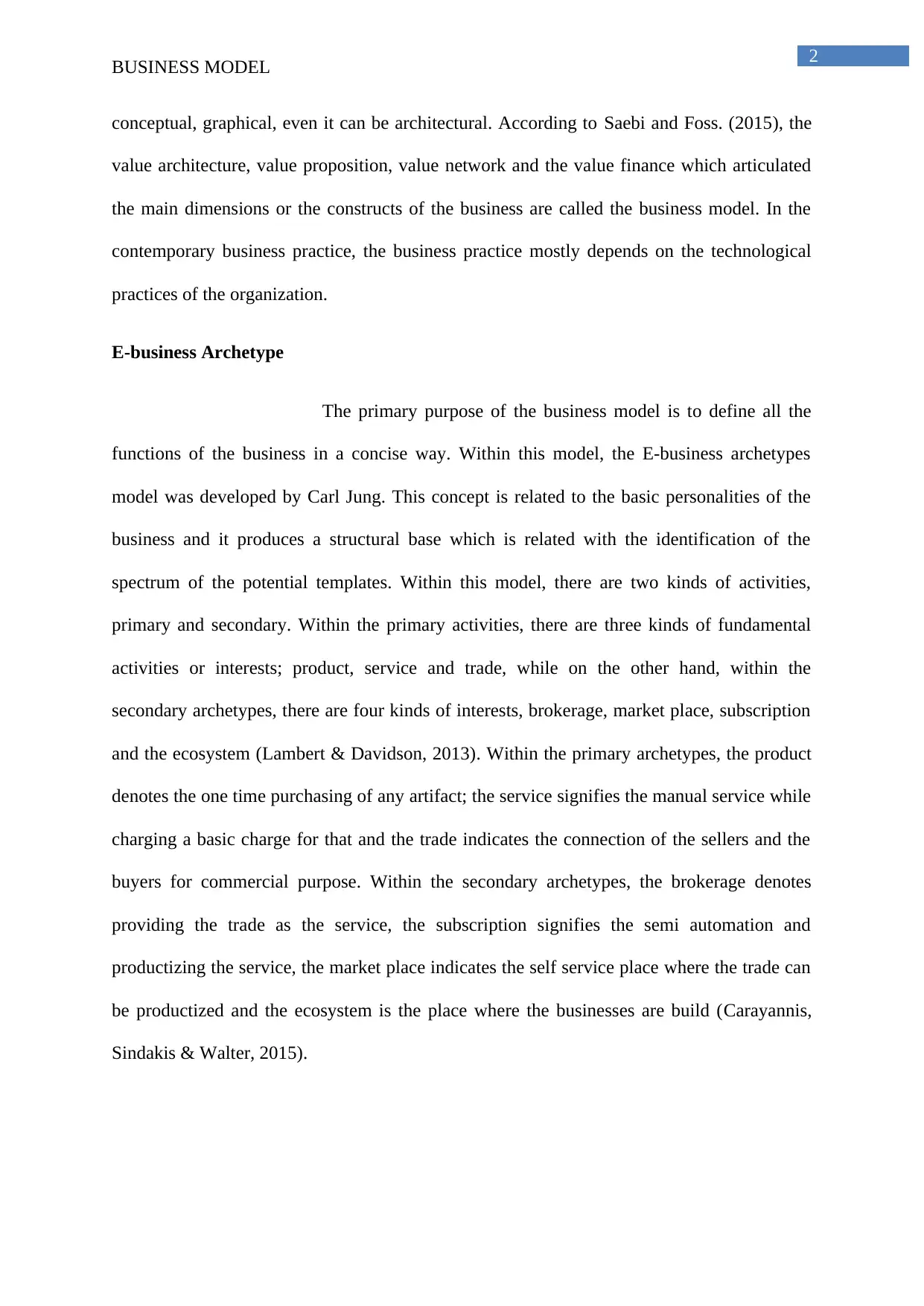
2
BUSINESS MODEL
conceptual, graphical, even it can be architectural. According to Saebi and Foss. (2015), the
value architecture, value proposition, value network and the value finance which articulated
the main dimensions or the constructs of the business are called the business model. In the
contemporary business practice, the business practice mostly depends on the technological
practices of the organization.
E-business Archetype
The primary purpose of the business model is to define all the
functions of the business in a concise way. Within this model, the E-business archetypes
model was developed by Carl Jung. This concept is related to the basic personalities of the
business and it produces a structural base which is related with the identification of the
spectrum of the potential templates. Within this model, there are two kinds of activities,
primary and secondary. Within the primary activities, there are three kinds of fundamental
activities or interests; product, service and trade, while on the other hand, within the
secondary archetypes, there are four kinds of interests, brokerage, market place, subscription
and the ecosystem (Lambert & Davidson, 2013). Within the primary archetypes, the product
denotes the one time purchasing of any artifact; the service signifies the manual service while
charging a basic charge for that and the trade indicates the connection of the sellers and the
buyers for commercial purpose. Within the secondary archetypes, the brokerage denotes
providing the trade as the service, the subscription signifies the semi automation and
productizing the service, the market place indicates the self service place where the trade can
be productized and the ecosystem is the place where the businesses are build (Carayannis,
Sindakis & Walter, 2015).
BUSINESS MODEL
conceptual, graphical, even it can be architectural. According to Saebi and Foss. (2015), the
value architecture, value proposition, value network and the value finance which articulated
the main dimensions or the constructs of the business are called the business model. In the
contemporary business practice, the business practice mostly depends on the technological
practices of the organization.
E-business Archetype
The primary purpose of the business model is to define all the
functions of the business in a concise way. Within this model, the E-business archetypes
model was developed by Carl Jung. This concept is related to the basic personalities of the
business and it produces a structural base which is related with the identification of the
spectrum of the potential templates. Within this model, there are two kinds of activities,
primary and secondary. Within the primary activities, there are three kinds of fundamental
activities or interests; product, service and trade, while on the other hand, within the
secondary archetypes, there are four kinds of interests, brokerage, market place, subscription
and the ecosystem (Lambert & Davidson, 2013). Within the primary archetypes, the product
denotes the one time purchasing of any artifact; the service signifies the manual service while
charging a basic charge for that and the trade indicates the connection of the sellers and the
buyers for commercial purpose. Within the secondary archetypes, the brokerage denotes
providing the trade as the service, the subscription signifies the semi automation and
productizing the service, the market place indicates the self service place where the trade can
be productized and the ecosystem is the place where the businesses are build (Carayannis,
Sindakis & Walter, 2015).
⊘ This is a preview!⊘
Do you want full access?
Subscribe today to unlock all pages.

Trusted by 1+ million students worldwide
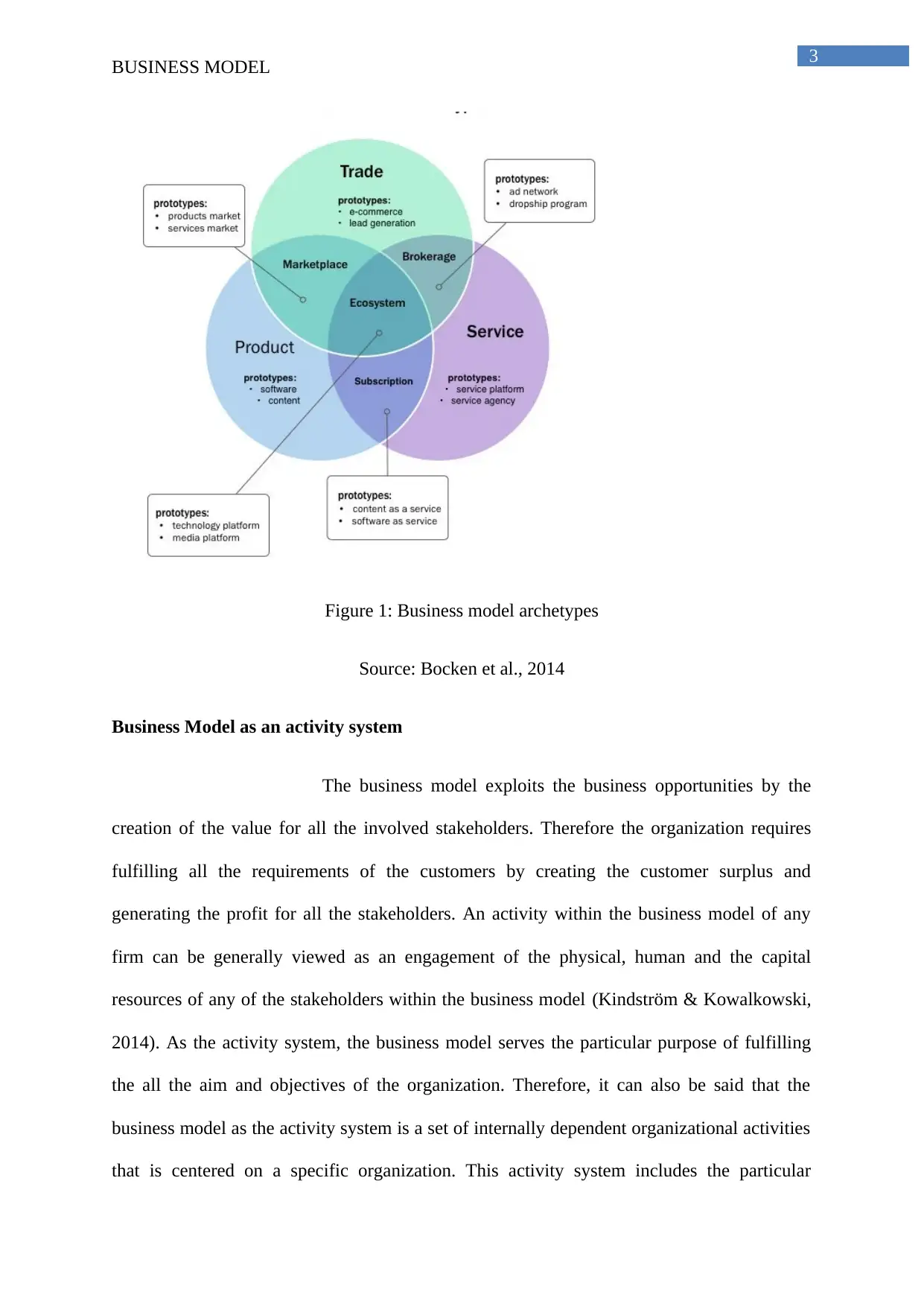
3
BUSINESS MODEL
Figure 1: Business model archetypes
Source: Bocken et al., 2014
Business Model as an activity system
The business model exploits the business opportunities by the
creation of the value for all the involved stakeholders. Therefore the organization requires
fulfilling all the requirements of the customers by creating the customer surplus and
generating the profit for all the stakeholders. An activity within the business model of any
firm can be generally viewed as an engagement of the physical, human and the capital
resources of any of the stakeholders within the business model (Kindström & Kowalkowski,
2014). As the activity system, the business model serves the particular purpose of fulfilling
the all the aim and objectives of the organization. Therefore, it can also be said that the
business model as the activity system is a set of internally dependent organizational activities
that is centered on a specific organization. This activity system includes the particular
BUSINESS MODEL
Figure 1: Business model archetypes
Source: Bocken et al., 2014
Business Model as an activity system
The business model exploits the business opportunities by the
creation of the value for all the involved stakeholders. Therefore the organization requires
fulfilling all the requirements of the customers by creating the customer surplus and
generating the profit for all the stakeholders. An activity within the business model of any
firm can be generally viewed as an engagement of the physical, human and the capital
resources of any of the stakeholders within the business model (Kindström & Kowalkowski,
2014). As the activity system, the business model serves the particular purpose of fulfilling
the all the aim and objectives of the organization. Therefore, it can also be said that the
business model as the activity system is a set of internally dependent organizational activities
that is centered on a specific organization. This activity system includes the particular
Paraphrase This Document
Need a fresh take? Get an instant paraphrase of this document with our AI Paraphraser
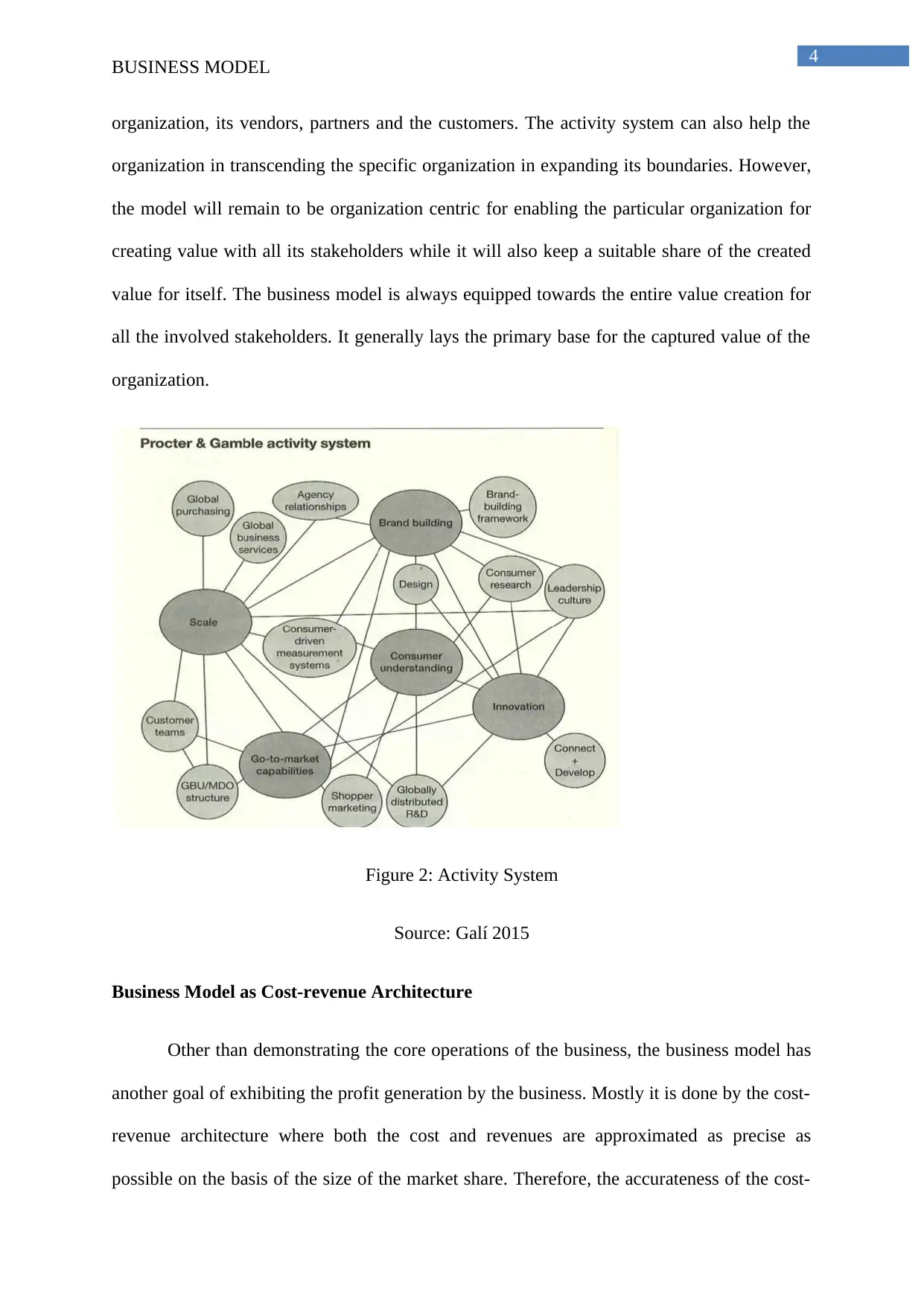
4
BUSINESS MODEL
organization, its vendors, partners and the customers. The activity system can also help the
organization in transcending the specific organization in expanding its boundaries. However,
the model will remain to be organization centric for enabling the particular organization for
creating value with all its stakeholders while it will also keep a suitable share of the created
value for itself. The business model is always equipped towards the entire value creation for
all the involved stakeholders. It generally lays the primary base for the captured value of the
organization.
Figure 2: Activity System
Source: Galí 2015
Business Model as Cost-revenue Architecture
Other than demonstrating the core operations of the business, the business model has
another goal of exhibiting the profit generation by the business. Mostly it is done by the cost-
revenue architecture where both the cost and revenues are approximated as precise as
possible on the basis of the size of the market share. Therefore, the accurateness of the cost-
BUSINESS MODEL
organization, its vendors, partners and the customers. The activity system can also help the
organization in transcending the specific organization in expanding its boundaries. However,
the model will remain to be organization centric for enabling the particular organization for
creating value with all its stakeholders while it will also keep a suitable share of the created
value for itself. The business model is always equipped towards the entire value creation for
all the involved stakeholders. It generally lays the primary base for the captured value of the
organization.
Figure 2: Activity System
Source: Galí 2015
Business Model as Cost-revenue Architecture
Other than demonstrating the core operations of the business, the business model has
another goal of exhibiting the profit generation by the business. Mostly it is done by the cost-
revenue architecture where both the cost and revenues are approximated as precise as
possible on the basis of the size of the market share. Therefore, the accurateness of the cost-
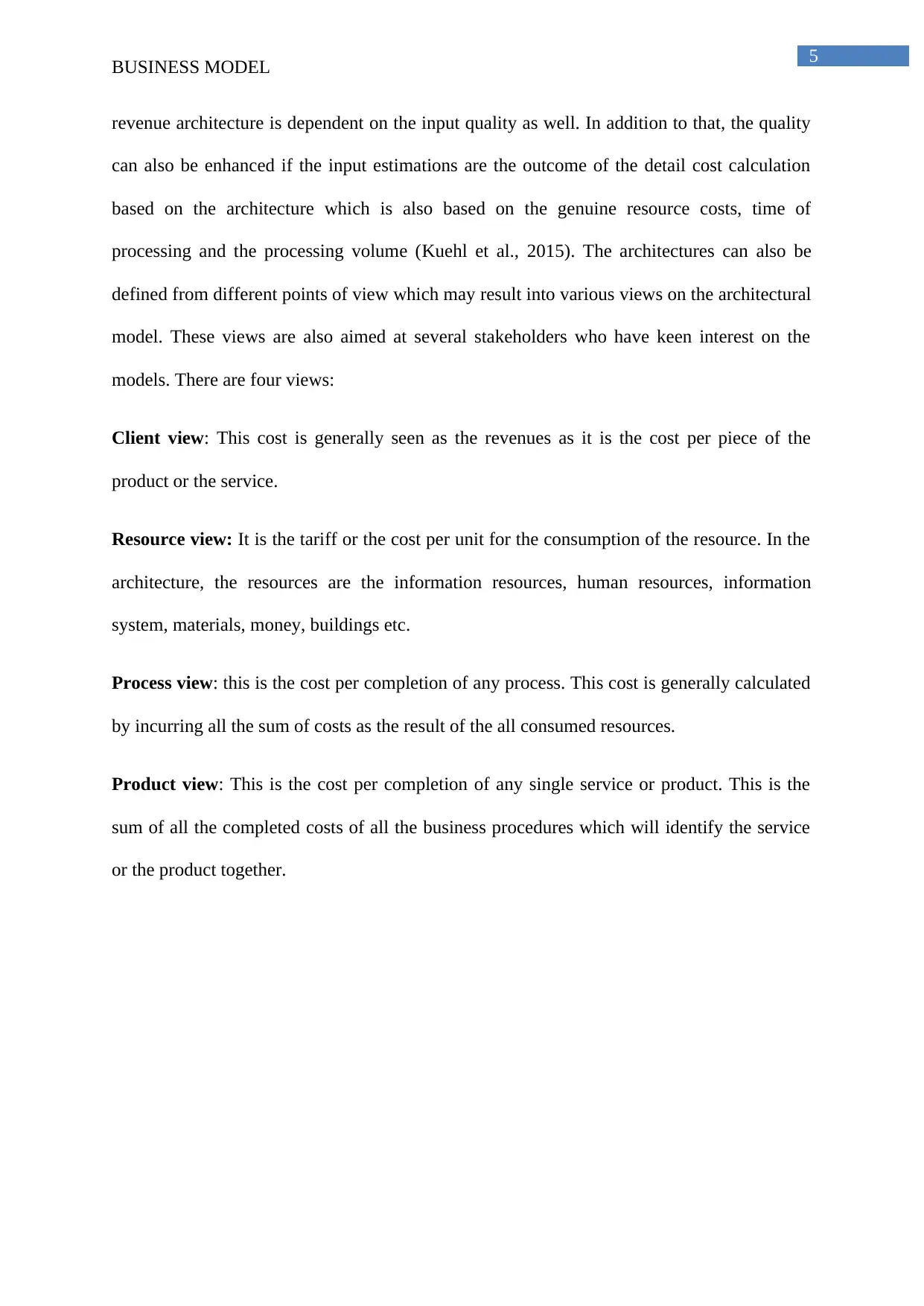
5
BUSINESS MODEL
revenue architecture is dependent on the input quality as well. In addition to that, the quality
can also be enhanced if the input estimations are the outcome of the detail cost calculation
based on the architecture which is also based on the genuine resource costs, time of
processing and the processing volume (Kuehl et al., 2015). The architectures can also be
defined from different points of view which may result into various views on the architectural
model. These views are also aimed at several stakeholders who have keen interest on the
models. There are four views:
Client view: This cost is generally seen as the revenues as it is the cost per piece of the
product or the service.
Resource view: It is the tariff or the cost per unit for the consumption of the resource. In the
architecture, the resources are the information resources, human resources, information
system, materials, money, buildings etc.
Process view: this is the cost per completion of any process. This cost is generally calculated
by incurring all the sum of costs as the result of the all consumed resources.
Product view: This is the cost per completion of any single service or product. This is the
sum of all the completed costs of all the business procedures which will identify the service
or the product together.
BUSINESS MODEL
revenue architecture is dependent on the input quality as well. In addition to that, the quality
can also be enhanced if the input estimations are the outcome of the detail cost calculation
based on the architecture which is also based on the genuine resource costs, time of
processing and the processing volume (Kuehl et al., 2015). The architectures can also be
defined from different points of view which may result into various views on the architectural
model. These views are also aimed at several stakeholders who have keen interest on the
models. There are four views:
Client view: This cost is generally seen as the revenues as it is the cost per piece of the
product or the service.
Resource view: It is the tariff or the cost per unit for the consumption of the resource. In the
architecture, the resources are the information resources, human resources, information
system, materials, money, buildings etc.
Process view: this is the cost per completion of any process. This cost is generally calculated
by incurring all the sum of costs as the result of the all consumed resources.
Product view: This is the cost per completion of any single service or product. This is the
sum of all the completed costs of all the business procedures which will identify the service
or the product together.
⊘ This is a preview!⊘
Do you want full access?
Subscribe today to unlock all pages.

Trusted by 1+ million students worldwide
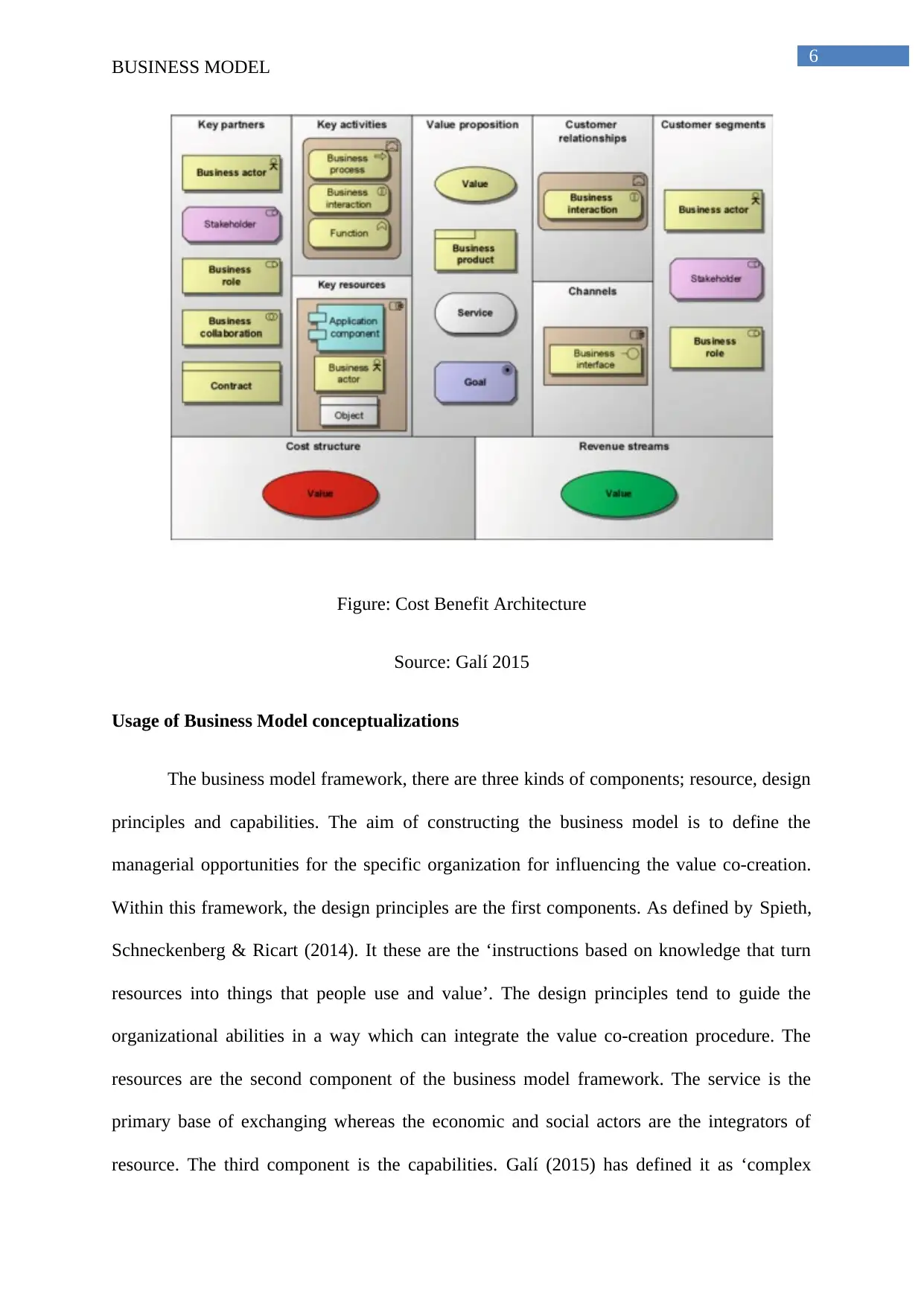
6
BUSINESS MODEL
Figure: Cost Benefit Architecture
Source: Galí 2015
Usage of Business Model conceptualizations
The business model framework, there are three kinds of components; resource, design
principles and capabilities. The aim of constructing the business model is to define the
managerial opportunities for the specific organization for influencing the value co-creation.
Within this framework, the design principles are the first components. As defined by Spieth,
Schneckenberg & Ricart (2014). It these are the ‘instructions based on knowledge that turn
resources into things that people use and value’. The design principles tend to guide the
organizational abilities in a way which can integrate the value co-creation procedure. The
resources are the second component of the business model framework. The service is the
primary base of exchanging whereas the economic and social actors are the integrators of
resource. The third component is the capabilities. Galí (2015) has defined it as ‘complex
BUSINESS MODEL
Figure: Cost Benefit Architecture
Source: Galí 2015
Usage of Business Model conceptualizations
The business model framework, there are three kinds of components; resource, design
principles and capabilities. The aim of constructing the business model is to define the
managerial opportunities for the specific organization for influencing the value co-creation.
Within this framework, the design principles are the first components. As defined by Spieth,
Schneckenberg & Ricart (2014). It these are the ‘instructions based on knowledge that turn
resources into things that people use and value’. The design principles tend to guide the
organizational abilities in a way which can integrate the value co-creation procedure. The
resources are the second component of the business model framework. The service is the
primary base of exchanging whereas the economic and social actors are the integrators of
resource. The third component is the capabilities. Galí (2015) has defined it as ‘complex
Paraphrase This Document
Need a fresh take? Get an instant paraphrase of this document with our AI Paraphraser
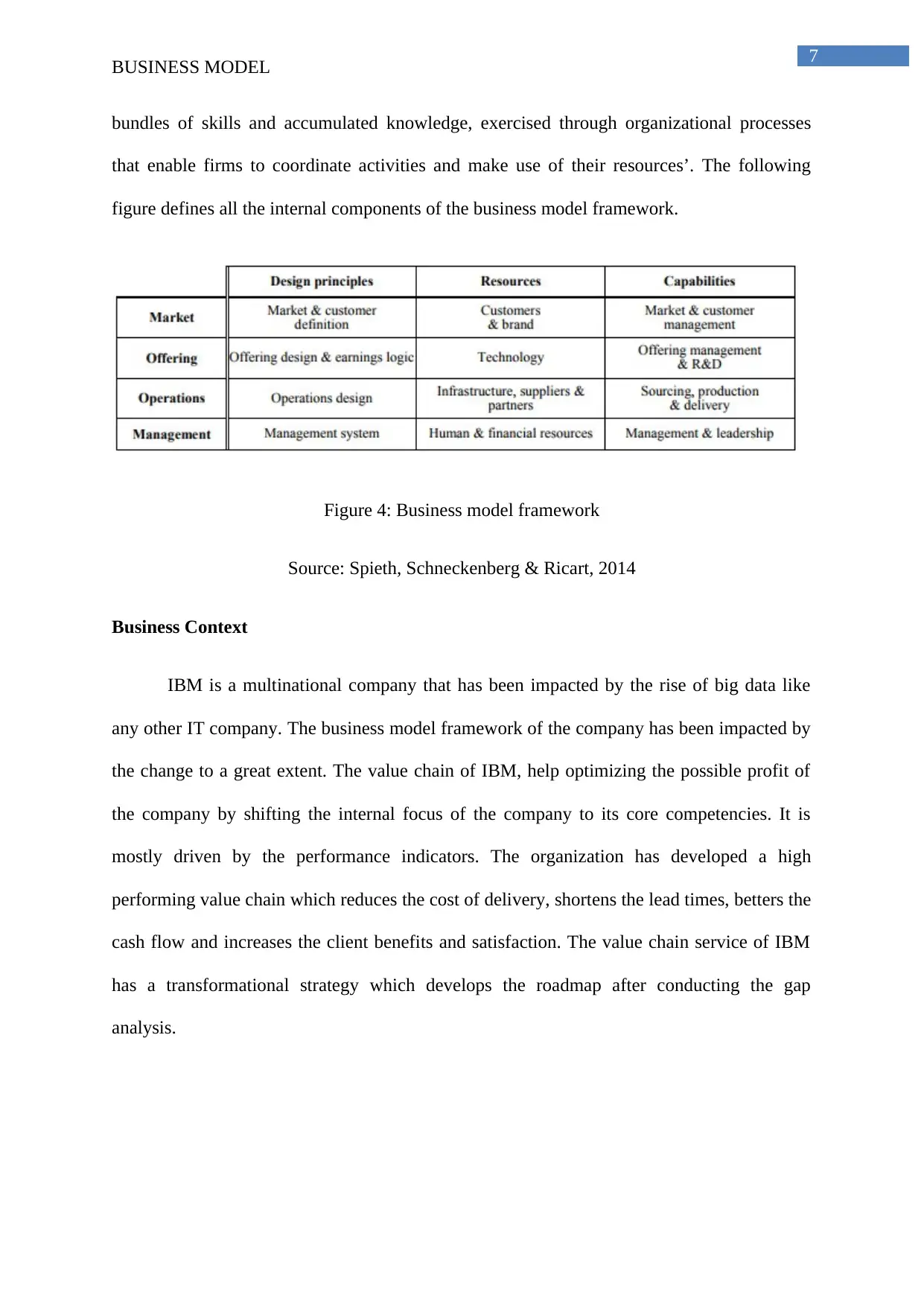
7
BUSINESS MODEL
bundles of skills and accumulated knowledge, exercised through organizational processes
that enable firms to coordinate activities and make use of their resources’. The following
figure defines all the internal components of the business model framework.
Figure 4: Business model framework
Source: Spieth, Schneckenberg & Ricart, 2014
Business Context
IBM is a multinational company that has been impacted by the rise of big data like
any other IT company. The business model framework of the company has been impacted by
the change to a great extent. The value chain of IBM, help optimizing the possible profit of
the company by shifting the internal focus of the company to its core competencies. It is
mostly driven by the performance indicators. The organization has developed a high
performing value chain which reduces the cost of delivery, shortens the lead times, betters the
cash flow and increases the client benefits and satisfaction. The value chain service of IBM
has a transformational strategy which develops the roadmap after conducting the gap
analysis.
BUSINESS MODEL
bundles of skills and accumulated knowledge, exercised through organizational processes
that enable firms to coordinate activities and make use of their resources’. The following
figure defines all the internal components of the business model framework.
Figure 4: Business model framework
Source: Spieth, Schneckenberg & Ricart, 2014
Business Context
IBM is a multinational company that has been impacted by the rise of big data like
any other IT company. The business model framework of the company has been impacted by
the change to a great extent. The value chain of IBM, help optimizing the possible profit of
the company by shifting the internal focus of the company to its core competencies. It is
mostly driven by the performance indicators. The organization has developed a high
performing value chain which reduces the cost of delivery, shortens the lead times, betters the
cash flow and increases the client benefits and satisfaction. The value chain service of IBM
has a transformational strategy which develops the roadmap after conducting the gap
analysis.
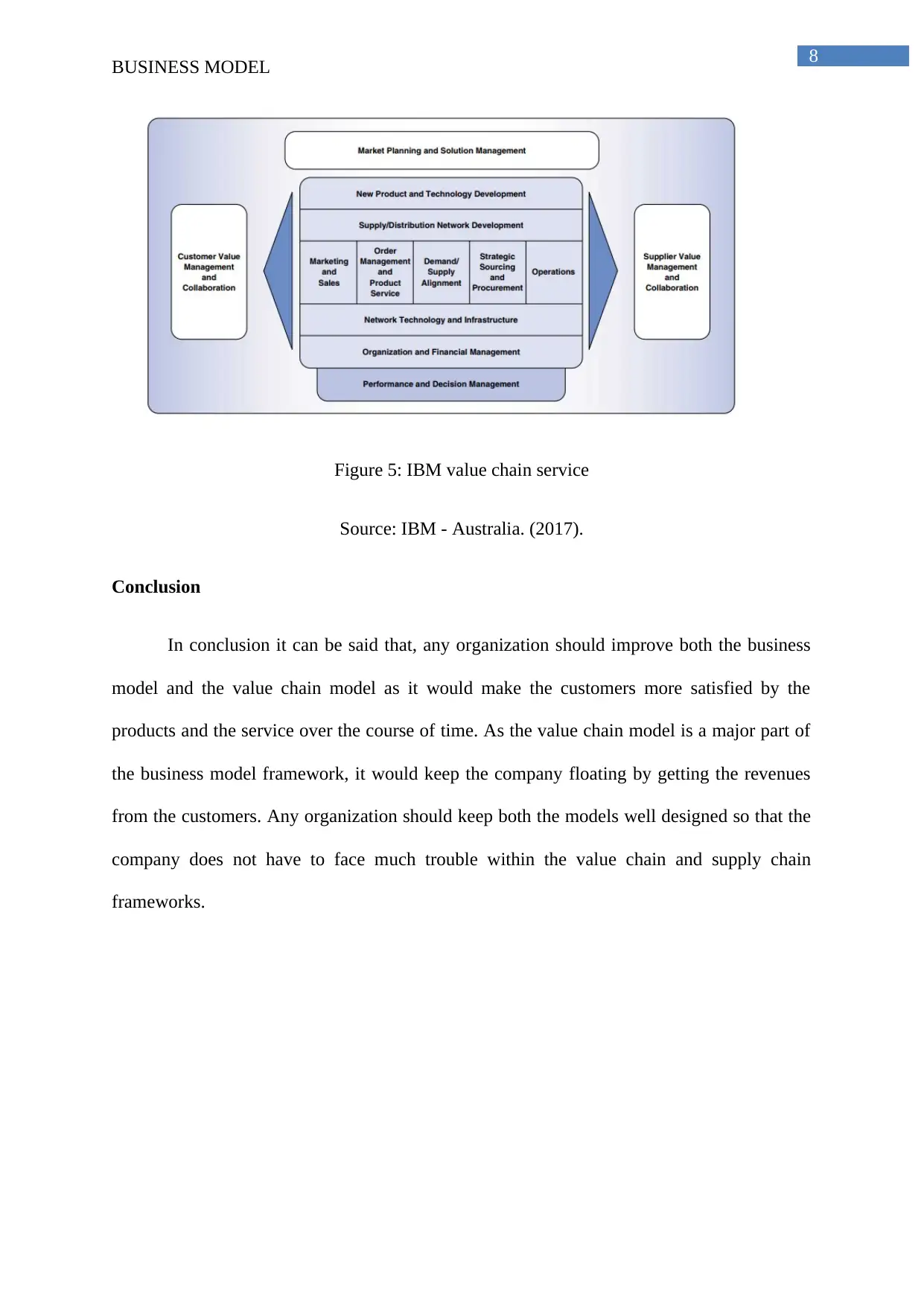
8
BUSINESS MODEL
Figure 5: IBM value chain service
Source: IBM - Australia. (2017).
Conclusion
In conclusion it can be said that, any organization should improve both the business
model and the value chain model as it would make the customers more satisfied by the
products and the service over the course of time. As the value chain model is a major part of
the business model framework, it would keep the company floating by getting the revenues
from the customers. Any organization should keep both the models well designed so that the
company does not have to face much trouble within the value chain and supply chain
frameworks.
BUSINESS MODEL
Figure 5: IBM value chain service
Source: IBM - Australia. (2017).
Conclusion
In conclusion it can be said that, any organization should improve both the business
model and the value chain model as it would make the customers more satisfied by the
products and the service over the course of time. As the value chain model is a major part of
the business model framework, it would keep the company floating by getting the revenues
from the customers. Any organization should keep both the models well designed so that the
company does not have to face much trouble within the value chain and supply chain
frameworks.
⊘ This is a preview!⊘
Do you want full access?
Subscribe today to unlock all pages.

Trusted by 1+ million students worldwide
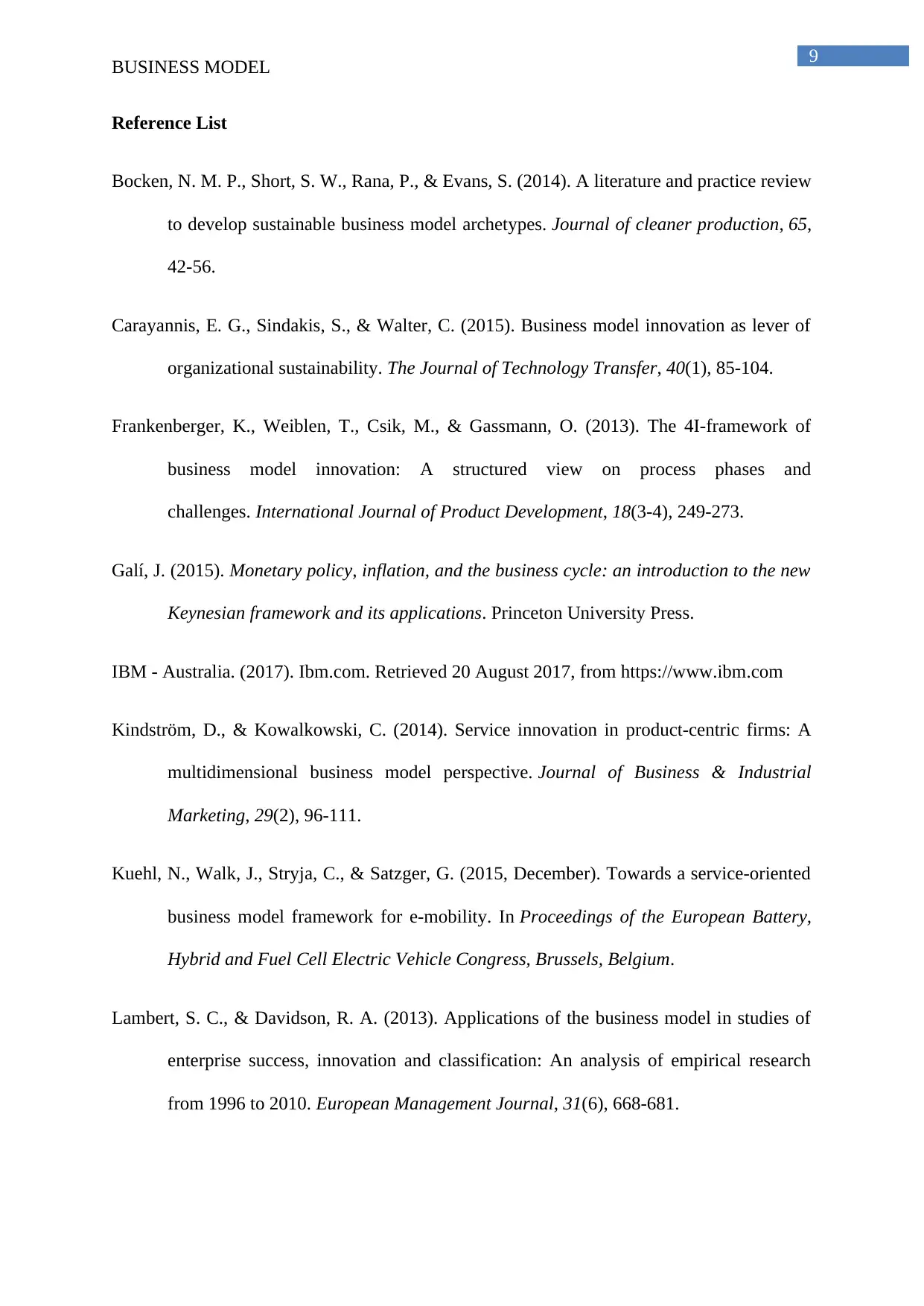
9
BUSINESS MODEL
Reference List
Bocken, N. M. P., Short, S. W., Rana, P., & Evans, S. (2014). A literature and practice review
to develop sustainable business model archetypes. Journal of cleaner production, 65,
42-56.
Carayannis, E. G., Sindakis, S., & Walter, C. (2015). Business model innovation as lever of
organizational sustainability. The Journal of Technology Transfer, 40(1), 85-104.
Frankenberger, K., Weiblen, T., Csik, M., & Gassmann, O. (2013). The 4I-framework of
business model innovation: A structured view on process phases and
challenges. International Journal of Product Development, 18(3-4), 249-273.
Galí, J. (2015). Monetary policy, inflation, and the business cycle: an introduction to the new
Keynesian framework and its applications. Princeton University Press.
IBM - Australia. (2017). Ibm.com. Retrieved 20 August 2017, from https://www.ibm.com
Kindström, D., & Kowalkowski, C. (2014). Service innovation in product-centric firms: A
multidimensional business model perspective. Journal of Business & Industrial
Marketing, 29(2), 96-111.
Kuehl, N., Walk, J., Stryja, C., & Satzger, G. (2015, December). Towards a service-oriented
business model framework for e-mobility. In Proceedings of the European Battery,
Hybrid and Fuel Cell Electric Vehicle Congress, Brussels, Belgium.
Lambert, S. C., & Davidson, R. A. (2013). Applications of the business model in studies of
enterprise success, innovation and classification: An analysis of empirical research
from 1996 to 2010. European Management Journal, 31(6), 668-681.
BUSINESS MODEL
Reference List
Bocken, N. M. P., Short, S. W., Rana, P., & Evans, S. (2014). A literature and practice review
to develop sustainable business model archetypes. Journal of cleaner production, 65,
42-56.
Carayannis, E. G., Sindakis, S., & Walter, C. (2015). Business model innovation as lever of
organizational sustainability. The Journal of Technology Transfer, 40(1), 85-104.
Frankenberger, K., Weiblen, T., Csik, M., & Gassmann, O. (2013). The 4I-framework of
business model innovation: A structured view on process phases and
challenges. International Journal of Product Development, 18(3-4), 249-273.
Galí, J. (2015). Monetary policy, inflation, and the business cycle: an introduction to the new
Keynesian framework and its applications. Princeton University Press.
IBM - Australia. (2017). Ibm.com. Retrieved 20 August 2017, from https://www.ibm.com
Kindström, D., & Kowalkowski, C. (2014). Service innovation in product-centric firms: A
multidimensional business model perspective. Journal of Business & Industrial
Marketing, 29(2), 96-111.
Kuehl, N., Walk, J., Stryja, C., & Satzger, G. (2015, December). Towards a service-oriented
business model framework for e-mobility. In Proceedings of the European Battery,
Hybrid and Fuel Cell Electric Vehicle Congress, Brussels, Belgium.
Lambert, S. C., & Davidson, R. A. (2013). Applications of the business model in studies of
enterprise success, innovation and classification: An analysis of empirical research
from 1996 to 2010. European Management Journal, 31(6), 668-681.
Paraphrase This Document
Need a fresh take? Get an instant paraphrase of this document with our AI Paraphraser
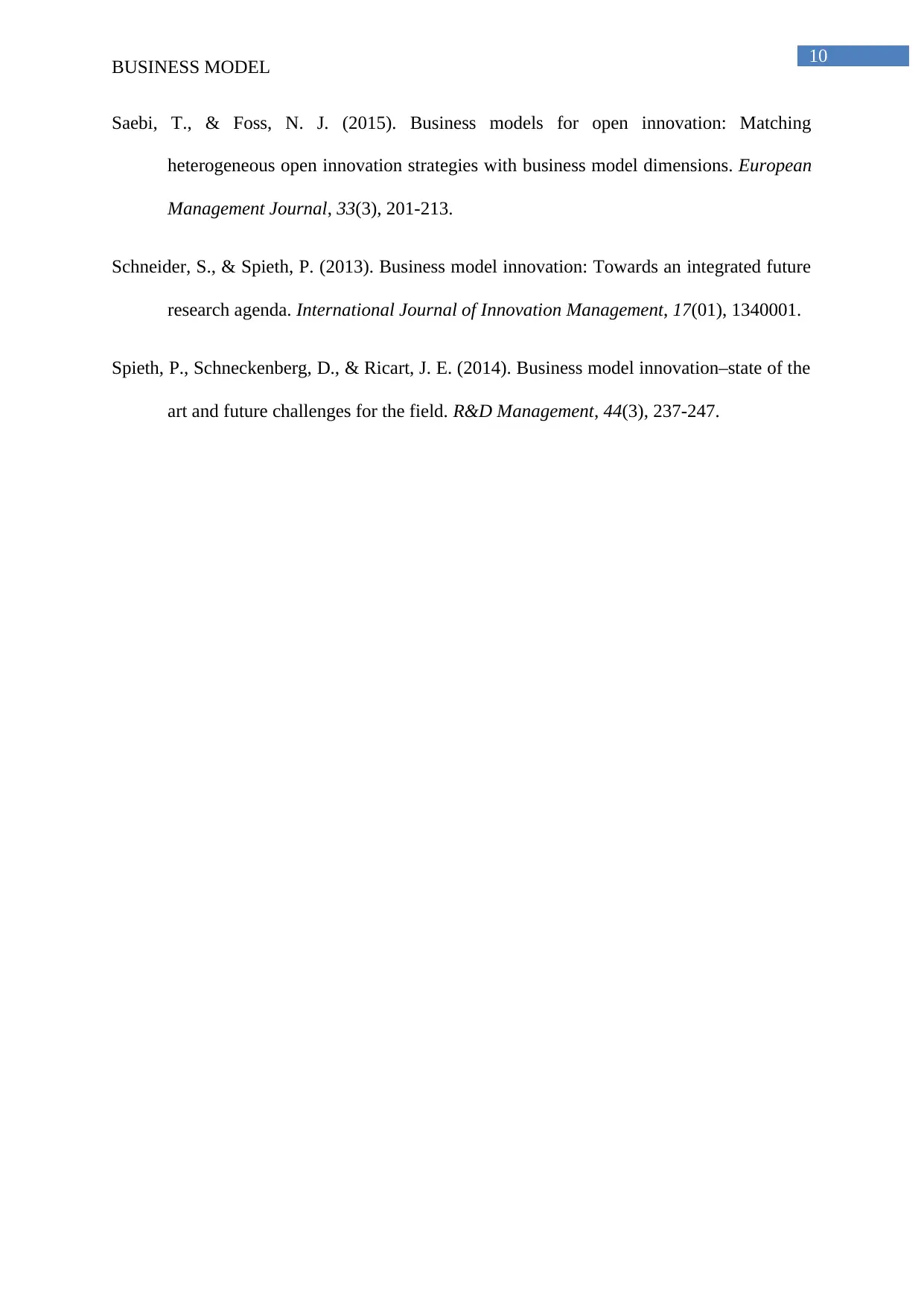
10
BUSINESS MODEL
Saebi, T., & Foss, N. J. (2015). Business models for open innovation: Matching
heterogeneous open innovation strategies with business model dimensions. European
Management Journal, 33(3), 201-213.
Schneider, S., & Spieth, P. (2013). Business model innovation: Towards an integrated future
research agenda. International Journal of Innovation Management, 17(01), 1340001.
Spieth, P., Schneckenberg, D., & Ricart, J. E. (2014). Business model innovation–state of the
art and future challenges for the field. R&D Management, 44(3), 237-247.
BUSINESS MODEL
Saebi, T., & Foss, N. J. (2015). Business models for open innovation: Matching
heterogeneous open innovation strategies with business model dimensions. European
Management Journal, 33(3), 201-213.
Schneider, S., & Spieth, P. (2013). Business model innovation: Towards an integrated future
research agenda. International Journal of Innovation Management, 17(01), 1340001.
Spieth, P., Schneckenberg, D., & Ricart, J. E. (2014). Business model innovation–state of the
art and future challenges for the field. R&D Management, 44(3), 237-247.
1 out of 11
Related Documents
Your All-in-One AI-Powered Toolkit for Academic Success.
+13062052269
info@desklib.com
Available 24*7 on WhatsApp / Email
![[object Object]](/_next/static/media/star-bottom.7253800d.svg)
Unlock your academic potential
Copyright © 2020–2025 A2Z Services. All Rights Reserved. Developed and managed by ZUCOL.





